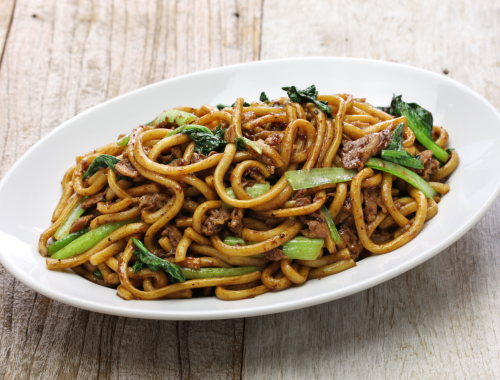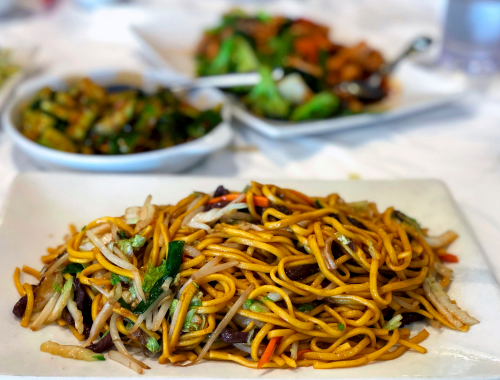Let’s talk about noodles. Think of noodles and the very first thing that comes to mind is chow mein. Then there’s lo mein too. These are undoubtedly two of the most popular Chinese dishes. And people’s love affair with Chinese food dates back more than a century. Today, Chinese dishes such as noodles are just as common as hamburgers and pizzas. There’s a high chance your kitchen drawer is packed with Chinese takeout menus, right? Coming to noodles, people often assume the difference in chow mein and lo mein lies in the type of noodle used, which is kind of true. In this article, we’ll look at the similarities between chow mein and lo mein.

What is chow mein?
Chow mein is a Chinese staple dish that literally means stir-fried noodles; chow means fried and mein is simply the Chinese word for noodles. It is often served as a specific dish at all western-style Chinese restaurants. In the U.S., chow mein consists of noodles, chicken, pork, beef or shrimp, onions and celery. It’s a popular Chinese take-out item, which consist of some shredded vegetables and some protein, along with the sauce that makes it a little tangy. Chow mein is soaked in hot water to soften up. The noodles are typically crisp and slightly fried, which adds a distinct texture to the dish.

What is lo mein?
In English, lo mein translated to tossed or stirred noodles, as opposed to chow mein, which means stir-fried noodles. Lo mein typically uses fat, chewy noodles that are fresh and boiled for a few minutes. It has a distinct method of preparation. The noodles are just tossed with sauce and other ingredients, so the flavor is soaked in. These noodles are boiled before stir-frying, which brings in a unique soft and silky texture. Since the best part of lo mein noodles is the sauce, most lo mein recipes often use more sauce than chow mein noodles. The noodles are not greasy as compared to chow mein.
Similarities between Chow Mein and Lo Mein
Ingredients
– Both chow mein and lo mein almost share the same components – noodles, proteins, vegetables, and sauce. The primary ingredient is of course noodles and includes a variety of vegetables, such as capsicum, onion, bell pepper, cabbage, mushrooms, bean sprouts, broccoli, celery, etc. Both are made with Chinese egg noodles – wheat flour noodles with eggs. They also contain protein, such as chicken, beef, or shrimp.
Flavor Profile
– Both the noodles are often seasoned with a wide variety of sauces, including soy sauce, oyster sauce, or hoisin sauce. The sauce is the real star of both the noodles, which gives a unique tangy flavor to the dish. The unique blend of flavors combined with the sweet and savory umami from the sauces and the natural sweetness of veggies give the dish a well-balanced flavor and great taste.
Customizability
– Both the noodles can be prepared in a variety of different ways to suit one’s taste and culinary preferences by experimenting with the selection and quantity of ingredients. The recipes can also be customized to vegan or vegetarian versions by removing the meat or seafood and focusing only on plant-based proteins such as tofu.
Versatility
– While both the noodles follow a distinct cooking style, lo mein shares the same benefits as chow mein – a quick and easy preparation and a great selection of vegetables. Both are commonly found on Chinese restaurants and take-out menus. Both are made with Chinese egg noodles, which are made with wheat flour with eggs added. Lo mein, however, requires fresh egg noodles as opposed to chow mein, which can be made with both fresh and dried egg noodles.
Summary
Both chow mein and lo mein use egg noodles, which are made with wheat flour and eggs. Despite having similar flavor profiles and choice of ingredients, chow mein and lo mein are very different. Chow mein noodles are stir-fried, hence the crispiness. Lo mein, on the other hand, are tossed or stirred noodles, so that explains the squishy texture. Besides, both can be loaded with lots of vegetables, sometimes as many veggies as noodles.
FAQs
Are chow mein noodles different than lo mein?
Chow mein noodles are stir-fried, hence the crispy taste. Lo mein noodles are tossed or stirred and are boiled for a few minutes, which explains the soft, tender texture. The differences lie in the cooking method, choice of ingredients, and the texture.
What dish is similar to Chow mein?
Stir-fried yakisoba is a classic Japanese dish made with stir-fried noodles, similar to chow mein. Similarly, yakisoba noodles are made of wheat and typically flavored with a great selection of vegetables and a sweet and savory sauce.
What noodle is similar to lo mein?
Udon noodle is a popular wheat-flour noodle used in the Japanese cuison and served and cooked in a variety of different ways and styles. Udon is thick, wheat-based noodle, similar to lo mein, and has a soft, chewy texture. This makes udon a great substitute for dishes that demand lo mein noodles.
Does chow mein or lo mein have more flavor?
Both the noodles are seasoned with a wide variety of sauces, including soy sauce, oyster sauce, or hoisin sauce. Chow mein noodles are typically crisp and slightly fried, while lo mein noodles are tossed or stirred noodles that are boiled and drained similar to ramen.
Which is healthier lo mein or chow mein?
Chow mein is typically fried, so it typically has a higher fat count. Besides, both the noodles are cooked in oil and sauce, which means more fat and sodium. Generally, because lo mein noodles are typically boiled, they are considered slightly healthier than chow mein.












Leave a Reply